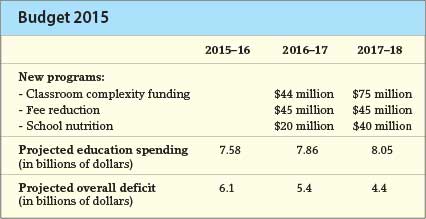Page Content
Ramsankar calls for more supports in future years
The New Democrats’ first provincial budget will maintain classroom conditions but does little to address systemic issues in public education, said Alberta Teachers’ Association president Mark Ramsankar.
In the budget released Oct. 27, the Notley government carried forward the revised 2015–16 funding profiles that school jurisdictions received in June after the government passed interim supply bills reversing the effects of the Progressive Conservatives’ March budget.
Capital budget expanding
Budget 2015 sets aside $1.3 billion to fund capital projects in education for the 2015–16 fiscal year. Nearly $1 billion will go toward the continuation of nearly 200 new school and modernization projects announced over the past three years. School boards will receive $180 million for infrastructure maintenance and renewal. An additional $50 million will go toward building modular classrooms and the completion of other school expansion projects. Over the next five years, the Alberta government plans to spend $4.7 billion on education-related capital projects.
|
Ramsankar called the NDP effort a status quo budget.
“Teaching and learning conditions will be about the same as last year and better than what was proposed by the last government,” he said. “But Alberta schools continue to be haunted by inadequate support for special needs students, cuts to English language learner programs and class sizes that are simply too large.”
The budget provides instructional funding for all of the estimated 9,700 additional students coming into Alberta’s schools and ensures that school boards can pay for teacher salary increases without affecting programming.
Government documents boast that the NDP budget offers school boards $90 million in additional funding compared to the March budget presented by the previous government. School boards report that this will result in the hiring of 380 additional teachers and 150 additional education assistants.
Preliminary figures collected within the ATA show that the teaching count for September is similar to last year, but it’s common for September numbers to be low as additional teacher hiring often occurs after the Sept. 30 student count has been completed, Ramsankar said.
Ramsankar would like to have seen immediate class-size reductions but acknowledged that this will take time given a downward trend in student support for the past six years. He also noted that the government has significant revenue challenges, with resource revenues dropping by more than two-thirds since last year.
“It is refreshing to see the government finally take steps to address revenue reform,” said Ramsankar. “But education has been chronically underfunded and more will need to be done in the years ahead.”
Two per cent increase
 In media reports, Education Minister David Eggen said the budget contains a number of three-year commitments that demonstrate the government’s efforts to help school boards plan better.
In media reports, Education Minister David Eggen said the budget contains a number of three-year commitments that demonstrate the government’s efforts to help school boards plan better.
“We put in long-term stable funding for the next three years,” said Eggen. “So, for the first time in a very long time, school boards can know where their funding level will be.”
“I think that goes a long way to providing security and better education outcomes for all Albertans,” he added.
The budget announced funding for three new programs starting in the fall of 2016, including $119 million over two years to address classroom complexity, $90 million over two years to reduce school fees and $60 million to initiate school nutrition programs.
In addition, the budget targets an increase of two per cent in each of the next two years in existing instructional funding for school boards. Most of this funding will be absorbed through costs related to increased enrolment as student population growth is projected to grow by 1.5 per cent in 2016–17 and 1.9 per cent in 2017–18.
Altogether, school board operational funding will rise from $7.2 billion in 2015–16 to $7.7 billion in 2017–18.
In a news release, Alberta School Boards Association president Helen Clease said there were no surprises in the budget.

“At this point in time, though we see increases over the next two fiscal years, there is no indication as to what flexibility local school boards will have in supporting student, school and community needs,” said Clease. “We need to have that conversation.”
Clease said that school boards will be asking the government to review the current funding model and develop one that provides more flexibility for local board decision making.
Wildrose education critic (and teacher) Mark Smith expressed concern over the impacts of government debt rising to nearly $50 billion in the next five years.
“Funding education is challenging now. What’s it going to be like in three or four years when we have a 50 billion dollar debt?” he said. “You can have the conversation about wanting to ensure that education is being funded appropriately, but if you’re doing it by spending your inheritance into the future, you’re just creating more problems for kids down the road.” ❚
